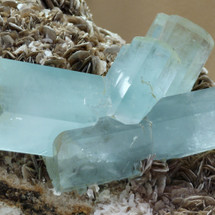Aug 23, 2023
All you need to know about: Aquamarine
Stone Variety: Blue Beryl
Colour: Varieties of blue. From pale blue, to greenish blue, to deep blue.
Hardness: 7.5-8 Mohs
Often a symbol of youth, health or spirit, Aquamarine is the blue variety of the Beryl family - siblings with Emerald and Morganite, the green and pink varieties. Named after seawater, a lot of the symbolism surrounding aquamarines has to do with - you guessed it - water. It was thought that wearing aquamarine during a voyage would encourage calm waves and keep sailors safe at sea. The clarity of the stone, often compared to the clearness of the water, also represents purity and a clear spirit.
Other symbols include enhancing the happiness of a marriage, protection from foes in battle by making the user unconquerable and quickening your intellect.
Known as the more popular birthstone for March, and shadowing its partner bloodstone, aquamarine is also the gemstone for a 19th wedding anniversary.
Although Brazil remains to be the world's leading source of aquamarines, they can be found all over the world, particularly in Russia, Afghanistan, Pakistan and Nigeria. Deposits have also been mined from the United States and here in Australia.
Aquamarines are most typically a clear and transparent blue but can range from light blue, to greenish-blue, to a deep blue, with the latter being the rarest and most expensive form of Aquamarine. These darker coloured aquamarines should not be confused with Maxixe, another blue beryl that loses colour over time that appeared in the market in the 1970s.
It's important to note that when Aquamarines are referred to as a Brazilian aquamarine or a Madagascar aquamarine, it does not necessarily mean it was mined there, but refers to the colour variety.
The largest aquamarine crystal mined to date was a Martha Rocha aquamarine, named after the Brazilian model for her similarly coloured eyes, which weighed in at 110kgs, and was almost 50cm long and 40cm wide. Currently, the world's largest cut aquamarine is the Dom Pedro, a 10,363ct carved obelisk.
Aquamarines require no special care: they are quite durable and are a popular stone for dress rings. If your aquamarine contains significant inclusions, it may be best to avoid mechanical cleaners, such as ultrasonics, as this could compromise the inclusion. Always check with your local jeweller or gemologist, and as with most stones, its important to get them checked regularly to make sure they are tight within their settings. You can clean these safely at home with a soft toothbrush, mild detergent and warm water, making gentle strokes to dislodge dust and dirt.
Do you dream of diving into the beautiful pool of the blue beryl? Click here to shop our range of Aquamarines!

